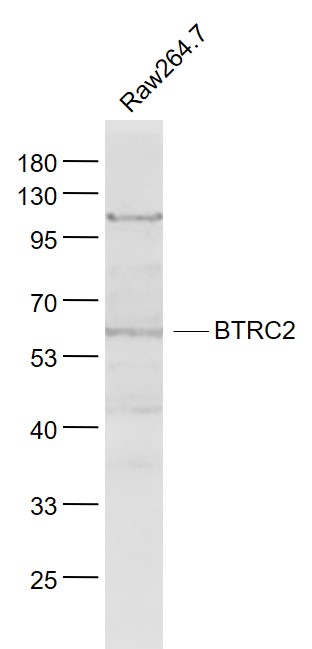BTRC2 Rabbit pAb
BTRC2 Rabbit pAb
- 产品详情
- 实验流程
- 背景知识
Application
| WB |
|---|---|
| Primary Accession | Q9UKB1 |
| Reactivity | Mouse |
| Predicted | Human, Rat, Chicken, Pig, Horse, Zebrafish |
| Host | Rabbit |
| Clonality | Polyclonal |
| Calculated MW | 62091 Da |
| Physical State | Liquid |
| Immunogen | KLH conjugated synthetic peptide derived from human BTRC2/beta TRCP2 |
| Epitope Specificity | 1-100/542 |
| Isotype | IgG |
| Purity | affinity purified by Protein A |
| Buffer | 0.01M TBS (pH7.4) with 1% BSA, 0.02% Proclin300 and 50% Glycerol. |
| SUBCELLULAR LOCATION | Cytoplasm. Nucleus. |
| SIMILARITY | Contains 1 F-box domain. Contains 7 WD repeats. |
| SUBUNIT | Self-associates. Component of the SCF(FBXW11) complex formed of CUL1, SKP1, RBX1 and a FBXW11 dimer. Interacts with BTRC, BST2, PER1, RCAN1 and USP47. Interacts with phosphorylated ubiquitination substrate PER2 (By similarity). Interacts with phosphorylated ubiquitination substrates CTNNB1, NFKBIA, IFNAR1; the interaction requires the phosphorylation of the two serine residues in the substrates' destruction motif D-S-G-X(2,3,4)-S. Interacts with TRIM21. |
| Important Note | This product as supplied is intended for research use only, not for use in human, therapeutic or diagnostic applications. |
| Background Descriptions | Beta TRCP2 is a member of the F-box protein family which is characterized by an approximately 40 amino acid motif, the F-box. The F-box proteins constitute one of the four subunits of ubiquitin protein ligase complex called SCFs (SKP1-cullin-F-box), which function in phosphorylation-dependent ubiquitination. The F-box proteins are divided into 3 classes: Fbws containing WD-40 domains, Fbls containing leucine-rich repeats, and Fbxs containing either different protein-protein interaction modules or no recognizable motifs. The protein encoded by this gene belongs to the Fbws class and, in addition to an F-box, contains multiple WD40 repeats. This gene contains at least 14 exons, and its alternative splicing generates 3 transcript variants diverging at the presence/absence of two alternate exons. |
| Gene ID | 23291 |
|---|---|
| Other Names | F-box/WD repeat-containing protein 11, F-box and WD repeats protein beta-TrCP2, F-box/WD repeat-containing protein 1B, Homologous to Slimb protein, HOS, FBXW11 {ECO:0000303|PubMed:26837067, ECO:0000312|HGNC:HGNC:13607} |
| Dilution | WB=1:500-2000 |
| Storage | Store at -20 °C for one year. Avoid repeated freeze/thaw cycles. When reconstituted in sterile pH 7.4 0.01M PBS or diluent of antibody the antibody is stable for at least two weeks at 2-4 °C. |
| Name | FBXW11 {ECO:0000303|PubMed:26837067, ECO:0000312|HGNC:HGNC:13607} |
|---|---|
| Function | Substrate recognition component of a SCF (SKP1-CUL1-F-box protein) E3 ubiquitin-protein ligase complex which mediates the ubiquitination and subsequent proteasomal degradation of target proteins (PubMed:10437795, PubMed:10648623, PubMed:11158290, PubMed:19966869, PubMed:20347421, PubMed:22017875, PubMed:22017876, PubMed:36608670). Probably recognizes and binds to phosphorylated target proteins: the interaction with substrates requires the phosphorylation of the two serine residues in the substrates' destruction motif D-S-G-X(2,3,4)-S (PubMed:10437795, PubMed:10648623, PubMed:19966869, PubMed:20347421, PubMed:22017875, PubMed:22017876, PubMed:36608670). SCF(FBXW11) mediates the ubiquitination of phosphorylated CTNNB1 and participates in Wnt signaling regulation (PubMed:10321728). SCF(FBXW11) plays a key role in NF-kappa-B activation by mediating ubiquitination of phosphorylated NFKBIA, leading to its degradation by the proteasome, thereby allowing the associated NF-kappa-B complex to translocate into the nucleus and to activate transcription (PubMed:10321728, PubMed:10437795, PubMed:10644755, PubMed:20347421). The SCF(FBXW11) complex also regulates NF-kappa-B by mediating ubiquitination of phosphorylated NFKB1: specifically ubiquitinates the p105 form of NFKB1, leading to its degradation (PubMed:11158290). SCF(FBXW11) mediates the ubiquitination of IFNAR1 (PubMed:14532120, PubMed:15337770). SCF(FBXW11) mediates the ubiquitination of CEP68; this is required for centriole separation during mitosis (PubMed:25503564). Involved in the oxidative stress-induced a ubiquitin-mediated decrease in RCAN1 (PubMed:18575781). Mediates the degradation of CDC25A induced by ionizing radiation in cells progressing through S phase and thus may function in the intra-S-phase checkpoint (PubMed:14603323). Has an essential role in the control of the clock-dependent transcription via degradation of phosphorylated PER1 and phosphorylated PER2 (PubMed:15917222). SCF(FBXW11) mediates the ubiquitination of CYTH1, and probably CYTH2 (PubMed:29420262). SCF(FBXW11) acts as a regulator of mTORC1 signaling pathway by catalyzing ubiquitination and subsequent proteasomal degradation of phosphorylated DEPTOR, TFE3 and MITF (PubMed:22017875, PubMed:22017876, PubMed:36608670). |
| Cellular Location | Cytoplasm {ECO:0000250|UniProtKB:Q5SRY7}. Nucleus {ECO:0000250|UniProtKB:Q5SRY7} |
For Research Use Only. Not For Use In Diagnostic Procedures.
Provided below are standard protocols that you may find useful for product applications.
BACKGROUND
Beta TRCP2 is a member of the F-box protein family which is characterized by an approximately 40 amino acid motif, the F-box. The F-box proteins constitute one of the four subunits of ubiquitin protein ligase complex called SCFs (SKP1-cullin-F-box), which function in phosphorylation-dependent ubiquitination. The F-box proteins are divided into 3 classes: Fbws containing WD-40 domains, Fbls containing leucine-rich repeats, and Fbxs containing either different protein-protein interaction modules or no recognizable motifs. The protein encoded by this gene belongs to the Fbws class and, in addition to an F-box, contains multiple WD40 repeats. This gene contains at least 14 exons, and its alternative splicing generates 3 transcript variants diverging at the presence/absence of two alternate exons.
终于等到您。ABCEPTA(百远生物)抗体产品。
点击下方“我要评价 ”按钮提交您的反馈信息,您的反馈和评价是我们最宝贵的财富之一,
我们将在1-3个工作日内处理您的反馈信息。
如有疑问,联系:0512-88856768 tech-china@abcepta.com.























 癌症的基本特征包括细胞增殖、血管生成、迁移、凋亡逃避机制和细胞永生等。找到癌症发生过程中这些通路的关键标记物和对应的抗体用于检测至关重要。
癌症的基本特征包括细胞增殖、血管生成、迁移、凋亡逃避机制和细胞永生等。找到癌症发生过程中这些通路的关键标记物和对应的抗体用于检测至关重要。 为您推荐一个泛素化位点预测神器——泛素化分析工具,可以为您的蛋白的泛素化位点作出预测和评分。
为您推荐一个泛素化位点预测神器——泛素化分析工具,可以为您的蛋白的泛素化位点作出预测和评分。 细胞自噬受体图形绘图工具为你的蛋白的细胞受体结合位点作出预测和评分,识别结合到自噬通路中的蛋白是非常重要的,便于让我们理解自噬在正常生理、病理过程中的作用,如发育、细胞分化、神经退化性疾病、压力条件下、感染和癌症。
细胞自噬受体图形绘图工具为你的蛋白的细胞受体结合位点作出预测和评分,识别结合到自噬通路中的蛋白是非常重要的,便于让我们理解自噬在正常生理、病理过程中的作用,如发育、细胞分化、神经退化性疾病、压力条件下、感染和癌症。






